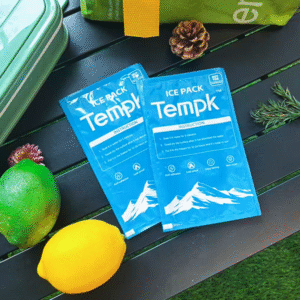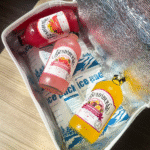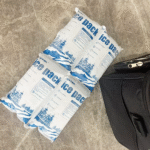Bulk Dry Ice Pack: 2025 Complete Guide to Safe Shipping
Intro: If you ship frozen goods, a bulk dry ice pack helps you hold sub‑zero temperatures for 24–72 hours while avoiding meltwater. It works by sublimation at ultra‑cold temperatures and scales cleanly from food to pharma lanes so you can ship farther with fewer losses.
-
Decide fast: dry ice vs. gel packs for your lane and target temperature.
-
Right‑size loads: a quick formula to estimate a bulk dry ice pack for 24–72 hours.
-
Ship safely: plain‑English rules for UN1845 and air/ground labeling.
-
Pack like a pro: a repeatable, step‑by‑step workflow you can train in minutes.
-
Plan 2025‑ready: trends that cut total cold‑chain cost by double‑digit percentages.
bulk-dry-ice-pack-2025-tempk
Do you really need a bulk dry ice pack or will gel packs do?
Short answer: Use a bulk dry ice pack when the product must stay frozen (≤ 0 °F / −18 °C) or ultra‑cold (down to −109 °F / −78 °C) for long routes. Choose gel packs for chilled lanes (2–8 °C) with simpler handling. This choice reduces spoilage and avoids unnecessary hazmat steps on short, refrigerated routes.
bulk-dry-ice-pack-2025-tempk
Why it matters: Dry ice gives longer hold times and no meltwater. Gel packs shine for short, chilled deliveries. Decide by target temperature, route duration, and moisture sensitivity. If liquid water is a risk, a bulk dry ice pack wins because CO₂ becomes gas, not liquid.
bulk_dry_ice_pack_article
Bulk dry ice pack chooser for common lanes
Details: Match your shipping goal to the refrigerant. For frozen seafood, vaccines, or biologics, you’ll benefit from the longer, drier cold curve of a bulk dry ice pack. For 2–8 °C foods or diagnostic kits, gel packs reduce complexity and fees. Start frozen, then validate with a lane trial.
bulk-dry-ice-pack-2025-tempk
| Shipping Goal | Best Refrigerant | Why it matters to you |
|---|---|---|
| Frozen (≤ 0 °F / −18 °C) for 24–72 h | Bulk dry ice pack | Long hold time, no meltwater, ultra‑cold capability
bulk_dry_ice_pack_article |
| Chilled (2–8 °C) | Gel packs | Easier compliance and handling
bulk-dry-ice-pack-2025-tempk |
| Mixed load (frozen + chilled) | Combo (dry ice + gel) | Stage zones with partitions/liners
bulk-dry-ice-pack-2025-tempk |
| Moisture‑sensitive goods | Bulk dry ice pack | Sublimes to gas; packaging stays dry
bulk_dry_ice_pack_article |
Practical tips and quick wins
-
Pre‑freeze product for 24 hours before packing.
-
Stage dry ice above the payload so CO₂ sinks and blankets the load.
-
Test once, ship many: run a trial on your longest lane and log temperatures and weight loss.
bulk-dry-ice-pack-2025-tempk
Real‑world case: A seafood shipper cut thaw losses from ~7% to ~1.5% by switching to bulk dry ice packs for two‑day lanes and adding a vented lid and liner.
bulk-dry-ice-pack-2025-tempk
How do bulk dry ice packs work—and which type should you buy?
In brief: A bulk dry ice pack is solid CO₂ in slab, brick, or pellet form. It sublimes—goes from solid to gas—near −78.5 °C, absorbing heat, holding frozen temps, and leaving no liquid residue. That’s ideal for foods, vaccines, and lab samples.
bulk_dry_ice_pack_article
What to buy:
-
Slabs/bricks (2–10 lb): slower sublimation, better endurance.
-
Pellet bags: faster pull‑down, good for quick freezing or pre‑conditioning.
-
Scored sheets/mini‑slabs: flexible placement around irregular loads.
bulk-dry-ice-pack-2025-tempk
How to size a bulk dry ice pack fast
Details: Start with 5–10 lb per 24 hours, then adjust for insulation and weather. Upgrade insulation (EPS → EPP → VIP) to reduce required weight. Add ~20% reserve for hot seasons or uncertain handoffs.
bulk-dry-ice-pack-2025-tempk
| Payload Volume (L) | Insulation Class | Hold Time (h) | Starting Dry Ice (lb) | What to adjust |
|---|---|---|---|---|
| 10–15 | EPS basic | 24–36 | 6–10 | Add 20% in hot weather |
| 20–25 | EPP mid | 36–48 | 12–18 | Use top slab + side rails |
| 30–40 | VIP high | 48–72 | 18–24 | Minimize voids; prefer slabs |
Simple formula:Dry ice (lb) ≈ (Hold time in hours / 24) × (5 to 10) × Lane factor
Lane factor: 1.0 (cool) to 1.3 (hot/last‑mile exposure).
bulk-dry-ice-pack-2025-tempk
What regulations apply to a bulk dry ice pack shipment?
Bottom line: Label, ventilate, and declare net weight. For air, follow UN1845 and IATA PI 954; for U.S. ground, 49 CFR 173.217. Use vented packaging—never airtight—and note dry‑ice net weight on the box. These basics prevent CO₂ buildup and speed carrier acceptance.
bulk-dry-ice-pack-2025-tempk
Quick compliance checklist (adapt to your SOP)
-
Marking: “Carbon Dioxide, Solid (Dry Ice), UN1845” + net weight.
-
Vent path: lid vent, gap, or factory vent cap—no sealed overwraps.
-
Aircraft: follow IATA PI 954; notify operator when required.
-
Vehicles/containers: ensure ventilation and hazard marking.
-
PPE: insulated gloves; avoid direct skin/eye contact.
-
Records: keep lane test data and pack‑out sheets.
bulk-dry-ice-pack-2025-tempk
How to pack a bulk dry ice pack safely—step by step?
Core workflow: Create a stable cold zone and a safe CO₂ escape path. Train this exact sequence for consistency.
bulk-dry-ice-pack-2025-tempk
-
Freeze product to final temp (≤ 0 °F) for ~24 h.
-
Pre‑condition the shipper (5–15 min with pellets).
-
Insert liner and splash‑proof bag if needed.
-
Load product tightly; keep voids under 10%.
-
Place the bulk dry ice pack above the payload on a perforated tray; add side rails for larger volumes.
-
Add a vent path (cap or 3–4 mm gap).
-
Label UN1845 and net weight; log ship time and temps.
-
Re‑ice at hubs if lanes exceed 72 h or ambient > 90 °F.
bulk-dry-ice-pack-2025-tempk
Avoid freeze damage and CO₂ risks
-
Insert a thin corrugate or perforated tray between dry ice and fragile packaging.
-
Separate dry‑ice freight from fresh‑produce zones to prevent incidental freezing.
-
Never place boxes in sealed plastic overwraps; CO₂ must vent.
bulk-dry-ice-pack-2025-tempk
Where do bulk dry ice packs deliver the most value?
Industries that benefit: Pharmaceuticals (vaccine integrity), food distributors (long routes for seafood/meat), and biomedical labs (specimen stability). Consistent sub‑zero holds support GDP and HACCP compliance.
bulk_dry_ice_pack_article
| Industry | Use Case | Temperature Requirement | Practical Benefit |
|---|---|---|---|
| Pharmaceutical | Vaccine transport | Down to −70 °C | Protects potency |
| Food & Beverage | Seafood/meat shipping | ~−40 °C | Prevents spoilage |
| Biomedical | Specimen transport | −78.5 °C | Maintains sample integrity |
2025 developments and trends shaping bulk dry ice packs
Trend overview: In 2025, adoption of the bulk dry ice pack expands as e‑grocery and life‑science lanes grow. Dry‑ice supply has stabilized versus pandemic spikes, and higher‑R packaging (EPP/VIP) cuts required weight, reducing total cold cost by double‑digit percentages in field trials. Automation and IoT logging make re‑icing predictable and auditable.
bulk-dry-ice-pack-2025-tempk
Latest advances at a glance
-
Smarter shippers: vented lids, re‑ice windows, logger pockets improve safety and QA.
-
Dynamic routing: weekend handoffs become normal; plan buffers over lab averages.
-
Sustainability: CO₂ recovery at plants gains traction; ask vendors for source disclosure.
bulk-dry-ice-pack-2025-tempk
Market insight: Expect more regional plants and better pellet/slab availability. VIP shippers and molded EPP commonly reduce dry‑ice mass by 10–25%, especially on 48–72 h lanes.
bulk-dry-ice-pack-2025-tempk
FAQs
Q1: How much dry ice do I need for 48 hours?
Start with 12–20 lb, depending on insulation (VIP needs less; EPS needs more). Run a lane test to confirm.
bulk-dry-ice-pack-2025-tempk
Q2: Can I fly a box with a bulk dry ice pack?
Yes. Mark UN1845, show net weight, use vented packaging, and follow IATA PI 954.
bulk-dry-ice-pack-2025-tempk
Q3: Can dry ice touch food directly?
Avoid direct contact. Use a tray or cardboard layer to prevent freezer burn or brittleness.
bulk-dry-ice-pack-2025-tempk
Q4: What’s the biggest safety risk?
CO₂ buildup in enclosed spaces and frostbite from contact. Ventilate, label, and wear insulated gloves.
bulk-dry-ice-pack-2025-tempk
Q5: When are gel packs better than a bulk dry ice pack?
When you only need 2–8 °C, want simpler handling, or have short routes under ~24–36 hours.
bulk-dry-ice-pack-2025-tempk
Q6: How long can a bulk dry ice pack last in transit?
Typically 24–72 hours, depending on insulation, ambient heat, and pack weight.
bulk_dry_ice_pack_article
Summary and next steps
Key points: A bulk dry ice pack delivers long, dry, sub‑zero holds for frozen lanes, scales across industries, and avoids meltwater. Size with the 5–10 lb/24 h rule, pack with dry ice above the payload, and ensure labeled, vented shippers. Validate with a lane test before rollout.
bulk-dry-ice-pack-2025-tempk
Action plan:
-
Run a 48‑hour trial with your hottest lane.
-
Log temps, dry‑ice loss, and handoffs.
-
Adjust weight and insulation, then publish the SOP.
CTA: Start with our Dry Ice Calculator (beta) and book a quick review.[Dry Ice Calculator](/tools/dry-ice-calculator)
About Tempk
We design and validate cold‑chain packaging that balances safety, compliance, and cost. Our team supports you from lane tests through SOPs, then trains staff on venting, labeling, and replenishment—so your shipments arrive frozen and intact. We focus on practical tools that reduce losses and simplify audits.
bulk-dry-ice-pack-2025-tempk
Talk to us: Book a free 20‑minute sizing review. [Contact Tempk](/contact)























